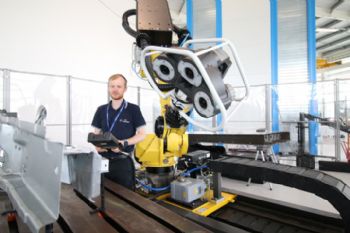
A 3-D optical scanner upgraded for the automated inspection of composites is being put through its paces at the University of Sheffield Advanced Manufacturing Research Centre (AMRC) to see how it can improve shopfloor productivity in the automotive and aerospace industries.
The Hexagon Blaze 600A uses three high-resolution cameras to capture data to generate 3-D models of the measured parts. It can be used to scan shiny, black and composite materials without the need for surface preparation, and its compatibility with robotic installations means that it no longer has to be manually guided by an operator.
Using Hexagon’s proven white-light scanner technology, the Blaze 600A combines high-resolution digital imaging technology with blue-light LED illumination to rapidly deliver high-accuracy freeform surface and feature data.
Its large measurement field efficiently captures high-density point-cloud data, while the enhanced projection technology enables virtually any material or surface type to be scanned.
Thomas Hodgson of the AMRC’s Integrated Manufacturing Group, who has been reviewing this ‘state of the art’ technology and testing its capabilities, said: “Traditionally, if you needed to scan something that was composite or a shiny metallic part, you used white spray, which dulls the surface and allows it to be scanned.
“The problem was that you had to clean the part and you had to buy the spray, which can be very costly.
“With the Blaze 600A, you don’t have to clean things — and that’s quite a big benefit.”
He said that faster inspection could have huge benefits not only for automotive manufacturers but also for the aerospace industry, which is increasingly favouring the use of composite materials in aircraft production.